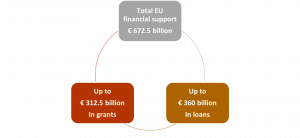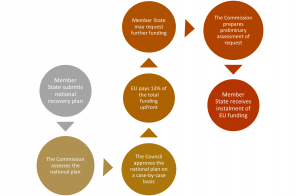Insights
Lawyers, Just Different
The EU’s Recovery and Resilience Facility
Introduction:
With 582 votes in favour, the Members of the European Parliament have approved and adopted the rules governing Europe’s renowned Recovery and Resilience Facility (the “RRF”). The RRF forms part of the €750 billion Next Generation EU recovery plan and has been dubbed as a key tool in curbing the pandemic’s devastating consequences.
The RRF offers a total €672.5 billion to Member States in an effort not only to recover from the tragic aftermath of Covid-19, but also to modernise and digitalize Europe.
Main Areas of Support:
The European Parliament has stressed that the RRF is to be used by Member States to further Europe’s long-term goals and priorities. The main areas of focus established by Members of the European Parliament are the following:
- environmental sustainability, including biodiversity
- digital transformation
- sustainable and inclusive growth
- social and territorial cohesion
- economic cohesion and competitiveness
- crisis preparedness
- policies for children and youth, including development of education and skills
Each Members State is expected to allocate at least 37% of the budget to climate/biodiversity and at least 20% to actions towards digital transformation. The RRF rules provide further that the cause of significant harm to the environment through the funding, will not be tolerated. Moreover, the essential principles of Europe and the rule of law must be observed and promoted by Member States in order for funding to be received.
RRF Breakdown:
The RRF funding will be made available in the form of grants and loans. The allocation will be broken down as follows:

Grants Allocation
The European Commission advised that an allocation key will fix a maximum possible amount for the grant component of the RRF per Member State.
For 70% of the total of €312.5 billion available in grants, the allocation key will take into account of the Member State’s population, its GDP per capita, and its average unemployment rate over the past 5 years (2015-2019), always compared to the EU average. For the remaining 30%, the formula will replace the 2015-2019 unemployment rate indicator by the observed loss in real GDP over 2020 and the observed cumulative loss in real GDP over the period 2020-2021.
Loans Allocation
The maximum volume of loans for each Member State will not exceed 6.8% of its Gross National Income. However, an increase will be possible in exceptional circumstances subject to available resources.
Process for Accessing EU Recovery Funding:

Member States are required to submit their national recovery and resilience plans by the 30th of April and the targets they include in their plans must be due for implementation by 2026. Funding will become available once Member States have reached their respective objectives, however, an upfront payment of up to 13% of the total requested funding shall be payable once the Council approves the national plan.
Transparency at the Forefront:
Transparency forms an integral part of the success of Europe’s recovery plan. To ensure an open and transparent dialogue, the Commission which is the body responsible for the monitoring of the RRF implementation, may be invited every two months to report on the progress of the program to parliamentary committees. Similarly, as is evident from the process for accessing the EU recovery funding, national recovery plans are subject to the review and approval of not only the Commission but also the Council.
Last but not least, the Commission will integrate a monitoring system through which Member States will inform it on the use of the funding and which is expected to assist the Commission in its reporting obligations on the implementation of the recovery program.
Striving for Change:
The RRF is the centrepiece of Europe’s recovery plan and one of the most significant investment initiatives available for Member States. The RRF is brought to alleviate the ruinous consequences of the pandemic and to offer substantial support to European countries through investments and reforms.
Beyond mitigating the impact of Covid-19, however, this initiative aims to modernise the post-pandemic landscape. The RRF (and Next Generation EU) is interlinked with Europe’s long-term targets and fundamental principles as is unambiguously evident through the qualifying criteria of the rules governing the adoption of the RRF. Economic and social cohesion, growth of biodiversity, healthcare preparedness and research and innovation development are only some of the underlying objectives to be achieved using the RRF. This recovery initiative is undoubtedly here to create a more sustainable and resilient Europe through a robust package of digital and environmental changes.
The foregoing should not be read or construed or relied upon as legal advice in any specific or individual circumstance.

